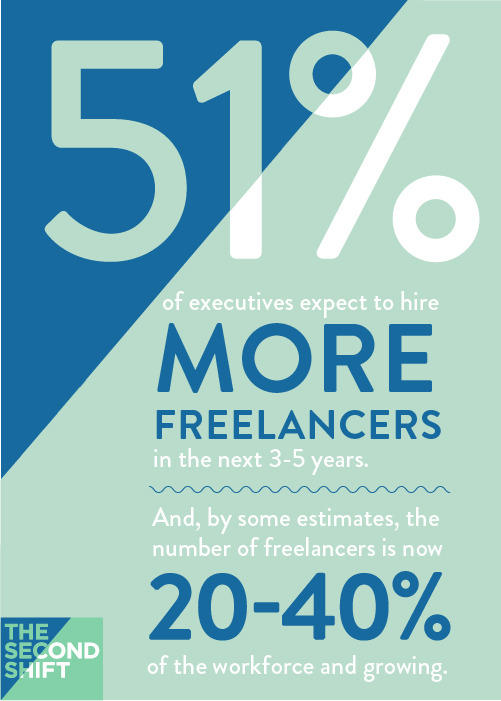
The gig economy is here. We’re living in a time in which
temporary positions are common and organizations of
all sizes are contracting with independent workers for short or long term
engagements.
In fact, a recent study showed 51% of executives expect to hire more
freelancers in the next 3-5 years. Businesses that are set up to
work well with contingent labor have a definite advantage—they can hire quickly,
onboard easily and effectively match skills to demand to drive productivity. In
short—they are agile! The most successful tech companies in the industry, including
Apple, Google, and Facebook, are set up to work with the professional gig
economy—are you?
At The Second Shift we help
high-growth start-ups, Fortune 500s, and many companies in between hire and
deploy expert talent from our network of vetted professionals. As a marketplace
that not only provides freelance talent, but
also utilizes resources from our pool to power our own growing business, we
have a particularly in-depth understanding of what it takes to maximize agile
talent. In our experience, the following five factors can make or break your success
in the gig economy:
Your Hiring
Process: There are few very specific details that should be
addressed before your organization even thinks about hiring freelance talent. These
details include:
- A Vendor Agreement –make sure that your
business is set up to work properly with independent contractors and vendor
approval is given to platforms such as The Second Shift. Establishing the right
foundation ahead of time will tremendously speed up your hiring process. - A Management Plan – an understanding of who
will post the job, who will participate in the interview process, who will make
the final hiring decision and who will extend the offer is key to landing the most
in demand resources. - An Onboarding Process – A plan for introducing
your freelancer to your company and your processes (including the process they
need to follow to get paid) is key to avoiding confusion and ramping up productivity.
Your Statement of Work (SOW): The benefit of hiring an expert freelancer
is that you are hiring a true professional. Once you’ve clearly communicated
the task, they should instinctively know the best way to get it done. Establishing
a detailed SOW that outlines expected deliverables, deadlines and performance
metrics is key to laying groundwork for success. The Second Shift automatically
prompts our experts to fill an SOW out once they are hired and clients must
approve before work can begin.
Your Plan
to Manage Politics: Managing internal politics with existing
employees can be tricky when new talent is brought in. Explaining up front that
a consultant is being brought in to augment their skills and support a
particular demand, such as coverage during a parental leave or much needed
expertise for a new business pitch will enable you to proactively address any potential
hard feelings and ensure positive participation.
Your Communication
Approach: Establishing your preferred method for open
and consistent communication with your team and expert before you begin any
work together is key. Does your team already use a tool like Slack or Trello?
If so, be sure to get your freelancer up to speed on your preferred method of
communication during the onboarding process. If not, have an open discussion
regarding what communication methods have worked best for them in the past and
agree on the best way forward.
Your
Feedback Loop: Once a project is done, freelancers want to
know how they’ve done. If you’ve had a positive experience, let them know by
taking the time to formally review them. You’ve successfully on boarded this
person, trained her on your culture, and created a win together, so why not to
maintain a friendly relationship and the ability to take advantage of hiring
her again in the future?
The gig economy is in full swing. It may be tempting to
rush in, but taking the time to examine any inefficiencies in your current
hiring and retention processes is key to being sure you hire the best talent for your needs. Share
your experience working with agile talent by leaving a comment below. Follow
our blog for out next post covering tips for engaging
freelancers from a Second Shift member who frequently works for both our
clients and us.